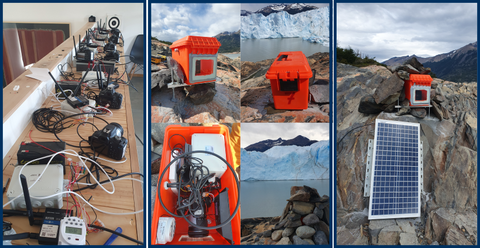Jan 30, 2025
Successful Installation of a 4D Multi-Sensor Monitoring System at Perito Moreno Glacier

Perito Moreno Glacier
Between December 2024 and January 2025, a five-week field campaign successfully installed a state-of-the-art 4D multi-sensor monitoring system at the Perito Moreno Glacier in Santa Cruz, Argentina. The goal of this groundbreaking project was to set up eight stable camera systems to capture the calving process and dynamics of one of the glacier fronts with unprecedented spatial and temporal resolution.

Installation Process of the Multi-Sensor Monitoring System at Perito Moreno Glacier
Precise 3D Reconstructions of the Glacier Front
The newly installed system enables the creation of stereoscopic 3D reconstructions of the glacier front across a width of 300 meters and a height of 65 meters. By analyzing these 3D models over time, deformations before calving, as well as calving magnitudes and frequencies, can be studied in detail.
Technical Implementation and Power Supply
The camera systems are designed to perform synchronized, automatic stereo imaging of the glacier front every 30 minutes during daylight. They are powered by solar panels and have an energy reserve that ensures more than ten days of autonomy even without direct sunlight. Thanks to a 4G data transmission system, the collected data can be analyzed almost in real-time, opening up new possibilities for investigating calving activity.
Extended Sensor Technology for Comprehensive Measurements
In addition to optical cameras, further sensors were installed and tested:
- Three thermal imaging cameras, which continuously collected data over five days and already documented initial calving activities.
- Low-cost seismometers, which capture glacier movements and potentially identify additional calving processes.
Initial Scientific Findings
The first analyses provide promising results:
- Visual observation of the glacier front movement using RGB and thermal imaging.
- Identification of initial deformations preceding calving events.
- Evidence of high dynamic activity at the glacier front, with documented calving events between approximately 10 and 65 meters in height.
- To date, more than 22,000 images have been captured, which can be used to calculate over 2,000 3D reconstructions.
A Significant Step for AI4Glaciers
This first field campaign represents a crucial milestone for the AI4Glaciers project funded by the DFG (German Research Foundation), which aims to predict glacier calving processes accurately by combining photogrammetry and artificial intelligence. The data obtained allows for a continuous investigation of dynamic instabilities at the glacier front and provides valuable insights for climate research.
Collaboration with the local community of El Calafate also fosters public interest in the scientific exploration of the Perito Moreno Glacier. This is reflected in an Interview with project members of the TUD Dresden University of Technology and the Universitat Politècnica de Catalunya (UPC) on the local news program "ahora Calafate", highlighting the importance of the research for the region. Similarly, an Article in the Argentina newspaper "LA NACION" further explores the research project, providing additional details about its objectives and potential results.